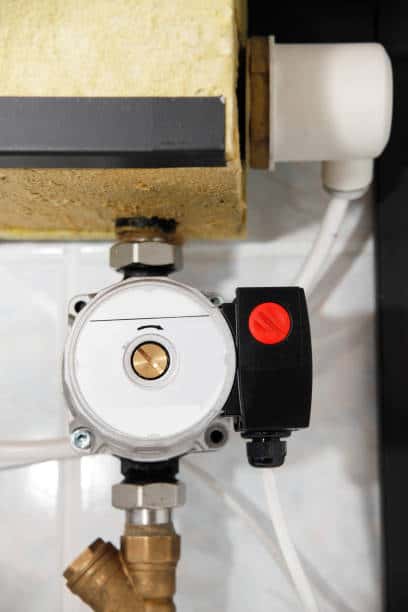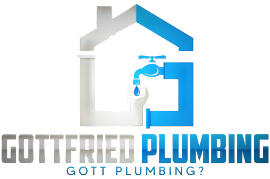24 Hour Emergency Service
License #43658 24 Hour Emergency Service Available (830) 331-2055
Hot Water Recirculation Pump System Installations & Replacement

Gottfried Plumbing LLC offers hot water recirculating pump installation and replacement services in Boerne, TX, and the surrounding areas. Recirculating systems provide instant heated water while saving your water and energy bills. We’re proud to provide this convenient service to homeowners and businesses.
Why choose us for your installation?
- Experienced licensed technicians
- Reliable fast service
- Transparent upfront pricing
- Family-owned & local Boerne company
- 24/7 emergency availability
Contact us at (830) 331-2055 to learn more about our recirculating pump services near you.
Benefits of a Hot Water Recirculation System
Recirculation pumps are used in residential and commercial plumbing to improve water efficiency, save time, and reduce energy costs. They are installed in both traditional tank water heaters and modern tankless systems.
Below are the benefits of water recirculating systems:
- Instant hot water: Say goodbye to waiting for heated water to reach your faucet or shower.
- Water conservation: Eliminate wasted water by reducing the time you let water run while waiting for it to warm up.
- Energy savings: Save energy costs by using a system that pumps heated water while sending cold water to reheat.
- Environmentally friendly: Contribute to water and energy conservation in your home or business.
Hot Water Recirculation Pumps: What You Need to Know
A hot water recirculation pump is also known as a demand water system or hot water circulating pump. It is a device that pumps instant heated water to faucets and showerheads when you need it. These pumps include a built-in timer or thermostat that you use to set when you want heated water available. With these systems, you don’t need to send cold water down to the water heater and wait for it to warm up.
How it works
When you turn on a faucet or shower, the pump draws heated water from the water heater and at the same time, it sends cold water back to be reheated and reused. The process saves both water and energy that would otherwise be wasted while waiting for the water to warm up. Recirculating systems can be installed either directly at the water heater or beneath kitchen or bathroom sinks with access to electrical outlets.
What it includes
A hot water recirculating pump kit typically includes the following components:
- Recirculation Pump: The main component that circulates heated water through your pipes.
- An Activation Device: Recirculating systems are activated by either a thermostat or a timer. The thermostat ensures the system operates when the water temperature drops below a set point. On the other hand, timers activate the system based on a pre-set schedule.
- Comfort/Aquastatic Valve: A valve that helps regulate water flow and temperature.
- Hose: A hose to connect the pump to the plumbing system.
- Adapter: An adapter to ensure compatibility with your existing water lines setup.
Additional comfort valves and other materials may be required for multi-unit properties. The kit does not include the water heater itself but is designed to work with your existing system.
Call (830) 331-2055 now!
Types of Hot Water Recirculation Systems
Demand Hot Water Recirculation System
A demand hot water recirculating system is activated when you need heated water. This type of system is designed to run only when prompted, either by a button press, motion sensor, or another activation device. When the system is activated, the pump circulates heated water from the water heater through the pipes to the faucet or shower. Once the water reaches the desired temperature, the system automatically shuts off. This type of system is energy-efficient because it operates only when necessary. Demand-controlled systems are ideal for homes or businesses where heated water is needed only at certain times, such as in bathrooms or kitchens.
Timer-Based Water Recirculating System
Timer-based water heater recirculating systems are equipped with a built-in timer that allows you to set specific operating hours. Once the timer is set, the system activates and circulates heated water to your taps. The system continuously circulates the water until the timer shuts it off. This setup is particularly beneficial for households with predictable schedules, such as in the morning or evening when people are most likely to use the water. Timer-based systems save energy by limiting their operation to specific times.

Continuous Hot Water Recirculation System
In a continuous water recirculation system, the pump operates all the time, circulating heated water through the pipes whenever you turn on the tap or shower. While continuous systems offer unmatched convenience, they also use more energy because the pump runs constantly, and heat is lost from the pipes over time. To mitigate energy waste, it’s advisable to use insulated pipes. Continuous recirculating systems are ideal for larger homes or commercial spaces where heated water is frequently needed at multiple points of use.
Now, there are no universally defined or definitive names to differentiate the various types of recirculating systems.
We can also use the terms dedicated loop and integrated loop to distinguish common system types. These are only descriptive terms.
Dedicated Loop System
In a dedicated loop system, a circulation pump is installed on the cooler side of the loop and connected to the water heater. The hot water pipe is installed in a loop throughout the home, passing near each plumbing fixture. Each fixture is connected to the loop via a short pipe. Since heated water is constantly circulating through this loop, any time a fixture’s valve is opened, heated water is immediately available. However, the system is often unplugged in unoccupied homes to avoid unnecessary energy consumption. This system requires more extensive installation due to the piping needed but offers long-term water conservation and convenience benefits.
Integrated Loop System
The integrated loop system is typically used in retrofits but can also be installed in new construction. It involves installing a pump under the plumbing fixture farthest from the water heater. The system contains a sensor that turns the pump on when the water temperature drops below 85°F and turns it off when it reaches 95°F (or any adjustable temperature range). The system operates intermittently, circulating hot water through the pipes and returning any cooled water to the water heater via the cold water line. This system raises the temperature of the cold water slightly but returns it to normal in a short time.
Call (830) 331-2055 to learn more about recirculating systems.
Hot Water Recirculating Pump Installation Boerne TX
A hot water recirculating pump installation takes under an hour in most cases. These systems are compatible with all types of water pipes.
The process of installing a recirculating system varies depending on the type of system and the water line configuration. Below’s a general overview of the process,
- Assessment and Planning
Before installation, a professional plumber will assess your home’s plumbing layout, water heater system, and the best location for the pump. For a dedicated loop system, the plumber will plan where to run the hot water loop throughout the home to ensure it passes by every fixture. For an integrated loop system, the plumber will identify the location of the fixture that is farthest from the water heater.
- Shutting Off Water Supply
As with any plumbing installation, the water supply must be turned off before work begins. This prevents leaks or water damage while the pump and piping are being installed.
- Installing the Pump
For a dedicated loop system, the pump is installed near the water heater on the cold side of the plumbing. The plumber will run the hot water pipe in a loop that passes near each fixture. At each fixture, a short pipe connects the loop to the hot water valve.
For an integrated loop system, the pump is typically installed under the fixture farthest from the water heater. The plumber will install the necessary fittings and sensors.
- Connecting the System to the Plumbing
For both systems, the pump needs to be connected to your existing plumbing. This often requires cutting into the hot and cold water lines to connect the system. The plumber will use appropriate fittings and seals to ensure all connections are secure and leak-free.
- Setting a Timer or Thermostat
Most recirculating systems use either a timer or a thermostat to control the system’s activation. The timer-based system is set to turn on and off at specific times, while the thermostat-based system activates when the water temperature falls below a set point.
- Testing the System
After installation, the plumber will test the system to ensure it is working properly. This includes checking for leaks, verifying the temperature control settings, and ensuring that heated water is delivered instantly to the fixtures. The plumber will also check that the pump is circulating water correctly.
- Insulating the Pipes
To maximize the system’s efficiency, insulating the water pipes is highly recommended. This step helps reduce heat loss. It also prevents the water heater from working harder to maintain the temperature.
- Final Walkthrough and Clean-Up
Once the system is installed and tested, the plumber will walk you through how it works and explain any settings or maintenance tips. The area will also be cleaned up to ensure no debris is left behind.
Factors to Consider During a Recirculation Pump Installation
- Water heater condition: Before installing a recirculating pump, ensure your water heater is in good working condition. If the water heater is old or leaking, it may need repairs or replacement before the system is installed.
- Energy usage: While recirculating systems are designed to save water and energy, systems that operate continuously may use more energy due to constant pumping and heat loss from poorly insulated pipes. A timer or thermostat is crucial to ensure the system only runs when necessary.
- System type: Depending on your needs and the layout of your home, you may choose a dedicated loop system for full coverage or an integrated loop system for a more energy-efficient and less invasive solution.
Call (830) 331-2055 now for an installation in Boerne, Texas!
Enjoy the benefits of hot water recirculating pumps
Instant Hot Water
One of the biggest advantages of installing a hot water recirculating pump is the immediate availability of heated water. No more waiting for water to heat up at the faucet or shower. These systems also contribute to water conservation by eliminating the need to let water run down the drain while waiting for it to heat up. For larger properties or multi-unit homes, recirculating systems can be particularly beneficial as they can serve several units at once, often requiring multiple comfort valves.
Energy and Water Efficiency
Recirculating water systems save energy and water. They can help save up to 15,000 gallons of water per year and reduce your water bill by as much as 10%. However, it is important to note that systems running continuously can use more energy due to both the pumping process and heat loss from the pipes. To maximize energy savings, it is recommended to use timers or smart devices to control the system.
Environmental Impact
Water recirculating systems can also help reduce water and energy waste. In the U.S., it is estimated that between 400 billion and 1.3 trillion gallons of water are wasted annually while waiting for heated water to reach the faucet. These systems also help reduce energy consumption by limiting municipal energy waste. For example, between 800 to 1,600 kilowatt-hours per year are used to treat and pump water that is eventually wasted while waiting for it to heat up.
Get Your Hot Water Heater Recirculating Pump Installation
Whether you’re looking for a commercial hot water recirculating pump to improve efficiency at your business or a home hot water recirculating pump for your household, Gottfried Plumbing LLC in Boerne, Texas, is here to help. Our team provides professional recirculation pump installation and replacement services to save time, water, and energy.
Call (830) 331-2055 for a free quote!
FAQs
A hot water circulating pump should be installed either at the water heater or under the sink furthest from the heater, depending on the system type. Talk to us about an under the sink recirculating pump installation in Boerne, Texas.
A hot water circulating pump is used to move heated water quickly through the pipes from the heater while simultaneously sending back cold water for heating. This prevents water wastage while waiting for it to heat up.
A recirculating pump can be added to most existing water heaters, though older models may require repairs or adjustments before installation.
The average cost to install a recirculating pump is $350 to $750, depending on the system type and the complexity of the installation.
